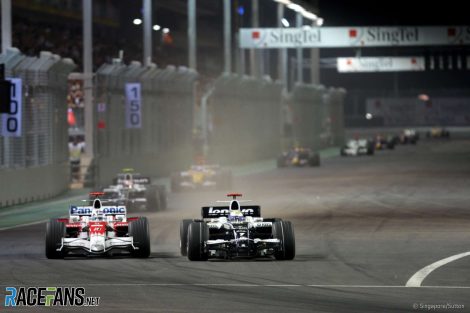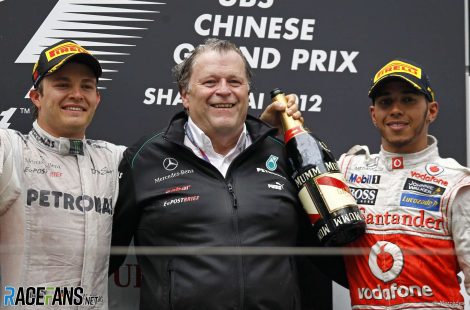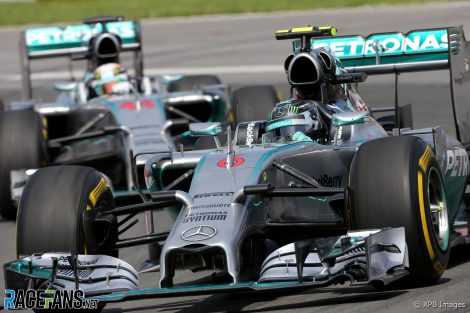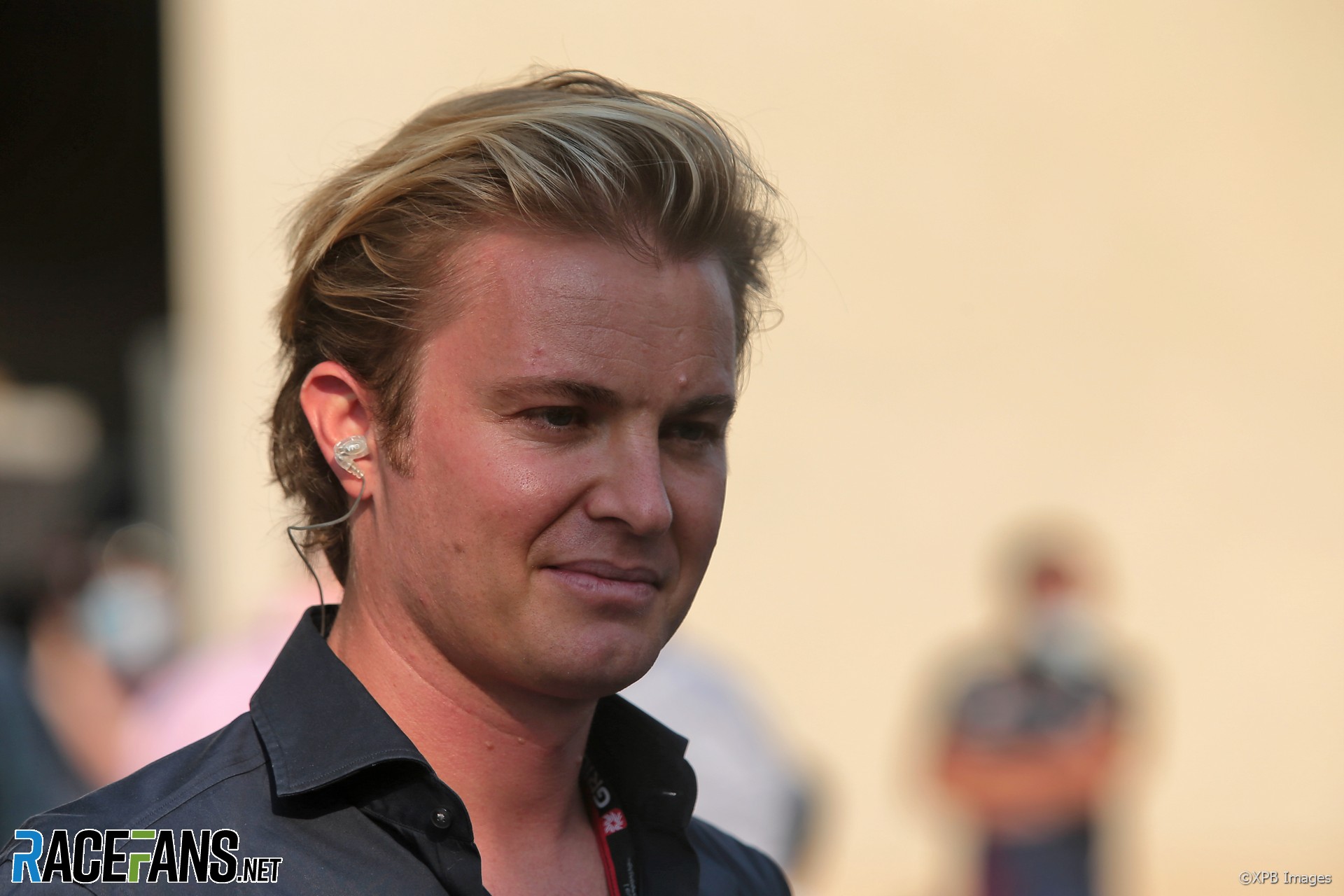Nico Rosberg, the son of Finnish 1982 world champion Keke Rosberg, was born in Germany and has dual nationality.
Birthplace: Wiesbaden, Germany
Find all RaceFans who support Nico Rosberg
Jump to:
Williams
Mercedes
Career stats
His karting career was backed by his father and in 2000 Rosberg Snr used his Mercedes connections to arrange backing for Nico to race with the support of top karting boss Dino Chiesa.
Team MBM.com (MBM standing for Mercedes-Benz McLaren) contested the 2000 Formula A championship with the Rosberg and McLaren’s young driver Lewis Hamilton. The pair ended the year at the top of the championship table – Hamilton ahead of Rosberg.
However Rosberg – the younger by five months – made it to F1 first.
Nico Rosberg biography
Formula Three
Rosberg stepped up to the German Formula BMW championship in 2002 and dominated the series, winning nine of 17 races and scoring 264 points to Maximillian Gotz’s 183. He spent the next two years in the Formula Three Euroseries driving for the team bearing his father’s name.
He was eighth in 2003 with a single win and got 2004 off to a perfect start with a pair of wins. But he only won twice more that year and ended the season fourth, one point ahead of Hamilton on his debut in the category.
The two saw more of each other in the Macau Grand Prix at the end of the year – Rosberg crashing out and taking Hamilton with him.
GP2
The new GP2 category, designed as a stepping stone to Formula One, was Rosberg’s destination for 2005. He partnered Alexandre Premat at the ART team and enjoyed a season-long battle with Heikki Kovalainen for the championship.There was considerable speculation over ART’s performance advantage over their rivals in the one-make series. Halfway through the season there was a furore over changes the team had made to their car’s steering column. But even when it was changed the ART pair remained the quickest.
Rosberg took the lead of the championship from Kovalainen with three races to go and hung on to win by 15 points with five wins and a total of 12 podium finishes. That led to a race seat for 2006 at Williams – the team his father had won the championship for 24 years earlier.
Williams
2006
He impressed immediately on his first outing at Bahrain, setting fastest lap. The rest of the season was muted by comparison, Rosberg making a few notable rookie errors, but flashes of speed were there on occasion too.
2007
His second year went far better, Rosberg consistently out-qualifying Alexander Wurz and shining with some excellent races. He ended the year on a high by beating both the BMWs in Interlagos to finish an excellent fourth, giving him a total of 20 points and ninth in the championship.
He was pursued by McLaren over the winter who wanted him to take the spare seat alongside Hamilton for 2008. Afterwards Frank Williams said: “I was a little surprised that he was happy to sign to stay. I feared he would go to McLaren, and I was a bit surprised he didn’t. He could not have gone there this year, he had a fixed contract, but 2009 was going to be the worry. We had an option for 2009 but it was very tough terms, based on the constructors’ championship. It was by no means guaranteed we would achieve it.”
2008

But the Williams renaissance had not arrived yet: most of the time the FW30 was not on the pace of the front runners, though Rosberg capitalised on a safety car period to score another podium in Singapore. Besides that, 2008 yielded little for him.
2009
Regular points finishes in 2009 attracted attention from the leading teams. However he wasn’t able to repeat his podium-scoring feats of 2008. He was on course for one at Singapore before making a mistake on his way out of the pits and incurring a penalty.
The mistake was atypical of what was otherwise an impressive campaign by Rosberg. He finished in the points 11 times – including eight races in a row in the middle of the season.
At the end of the year he signed for Mercedes, who had took over 2009 championship winners Brawn.
Advert | Become a RaceFans supporter and
Mercedes
2010
Rosberg quickly dismissed any questions over his ability to compete with team mate Michael Schumacher, and consistently out-paced the seven-times champion throughout 2010.
But the Mercedes W01 wasn’t the instant race-winner its Brawn predecessor had been – the team went all year without a victory.
Rosberg came close, leading in the early stages at Shanghai in the rain. And he put the car on the front row of the grid in a wet qualifying session in Sepang.
He briefly looked on course for a strong result in Korea, passing Hamilton early on, but was taken out by Mark Webber after the Red Bull driver hit the wall.
Rosberg ended the year just a few points behind Felipe Massa in the championship. With better luck – particularly his wheel failures in Hungary and Japan – he might have done even better. As it was, his points tally was almost double Schumacher’s.
2011
The gap between the pair closed considerably in 2011 but Rosberg retained the upper hand. In particular, he dominated Schumacher in qualifying, starting in front of his team mate at almost every race.
He led on more than one occasion, including in China, where he was in contention for victory until the team realised they had their fuel calculations wrong and had to tell Rosberg to back off.
By the end of the season the two Mercedes drivers were often disputing the same piece of road and Rosberg had to put a strong move on Schumacher to keep him behind at Abu Dhabi.
Advert | Become a RaceFans supporter and
2012

It looked like it was the beginning of a strong season for Rosberg. He followed it up with second place in Monaco and chances for better finishes had been in the offing at Melbourne and Bahrain, only for him to make errors during qualifying.
But the team’s form fell as the season progresses and Rosberg’s chances of further podium finishes went along with it. Towards the end of the year they seemed more preoccupied with getting to the bottom of errors made in the car’s development in preparation Hamilton’s arrival as Rosberg’s team mate in 2013.
2013
Sharing a team with Hamilton proved a further boost to Rosberg’s reputation as he won two races to his team mate’s one during their first year together. He ran his new world champion team mate close in the points standings as well.
Rosberg’s first win came in Monaco, where he started from pole position and resisted race-long pressure to emulate his father’s achievement of 30 years earlier. A second win at Silverstone was fortunate, though Rosberg also suffered at the hands of unreliability during the year.
2014

Arguably Rosberg’s most impressive feat was taking more pole positions than his team mate, who had always been considered one of the very best over a single flying lap. That earned Rosberg the first FIA Pole Position trophy.
But it couldn’t help him keep his team mate back, notably in Bahrain, Japan, America and Abu Dhabi where Hamilton came from behind to win. The latter saw the end of Rosberg’s title hopes when his car failed as he tried to give chase of his team mate.
There were a few controversial run-ins between the pair earlier in the year. Rosberg scored his second consecutive Monaco Grand Prix victory largely thanks to starting from a pole position which he earned in contentious circumstances. In Belgium he clipped Hamilton while battling for position, giving his team mate a puncture which ruined his race, while Rosberg collected a useful 18 points for second place.
However when the chequered flag fell on the season Rosberg readily admitted his team mate’s championship was well-earned.
2015
Rosberg rarely looked likely to take Hamilton’s title away from him during 2015. Crucially the advantage he enjoyed in qualifying deserted him: over the first 12 races Hamilton took pole position 11 times. While Hamilton built up a healthy lead in the championship Rosberg managed just three wins: in Spain where he took a rare pole position, in Austria where he beat Hamilton off the line, and in Monaco where Hamilton threw away victory with an unnecessary pit stop.
Technical problems in Russia (while he was leading) and Italy pushed the pendulum further in favour of his team mate. Rosberg’s final defeat came in particularly galling circumstances: having taken the lead in a frantic, wet-dry race at the Circuit of the Americas, a late slip allowed Hamilton through to win the race and the title.
Rosberg, however, had already begun to turn his season around. The United States Grand Prix was the third race in a row where he had beaten Hamilton to pole, and not only did he sustain that over the final three races he won every time too. His frustrated team mate pressed the team to allow him to use more unorthodox strategies to take on Rosberg, but even when Hamilton had that chance in Abu Dhabi it was Rosberg who triumphed again, raising hopes of a closer contest between the pair in 2016.
2016
Rosberg sustained his winning streak as the new season began, winning four of the year’s opening races. Poor starts and reliability problems compromised Hamilton’s start to the year, and when the pair went wheel-to-wheel on lap one in Spain the pair collided and retired on the spot.
As the championship’s longest-ever, 21-race season ground on Hamilton gradually whittled away Rosberg’s points lead. A string of decisive wins while Rosberg struggled, notably in wet races in Monaco and Britain, helped Hamilton to a 19-point lead.
Rosberg returned from the summer break with renewed energy. Another series of setbacks hit Hamilton and Rosberg set about restoring his championship lead. His run was almost derailed in Malaysia, where Vettel tipped him into a spin at the start. But Rosberg fought back to third place while a power unit failure put Hamilton out while he was leading. Rosberg’s ninth victory of the season in Japan put him in a strong position heading into the final four races.
Hamilton unleashed a fresh onslaught in the championship run-in, taking a clean sweep of all the remaining races. But Rosberg could afford to finish second every time to secure the crown, which is exactly what he did. Despite a tense conclusion in Abu Dhabi, where Hamilton backed off to slow Rosberg down at the start and end of the race, Rosberg finally prevailed and took the title by a five-point margin.
What happened next took everyone by surprise. With his championship crown newly minted, just five days after the chequered flag had fallen in Abu Dhabi, Rosberg told the world he was done with racing, and retired from F1 on the spot.
Articles
Featured articles
All articles
- Red Bull should give Verstappen a competitive team mate like Hamilton had – Brawn
- No Ferrari staff changes insists Binotto as Rosberg calls them ‘worse than F3 teams’
- Bottas vs Rosberg: Hamilton’s Mercedes team mates compared after 78 races each
- Button joins fellow F1 champions Hamilton and Rosberg with Extreme E team
- Bottas is not pushing Hamilton as hard as Rosberg did, says Button




